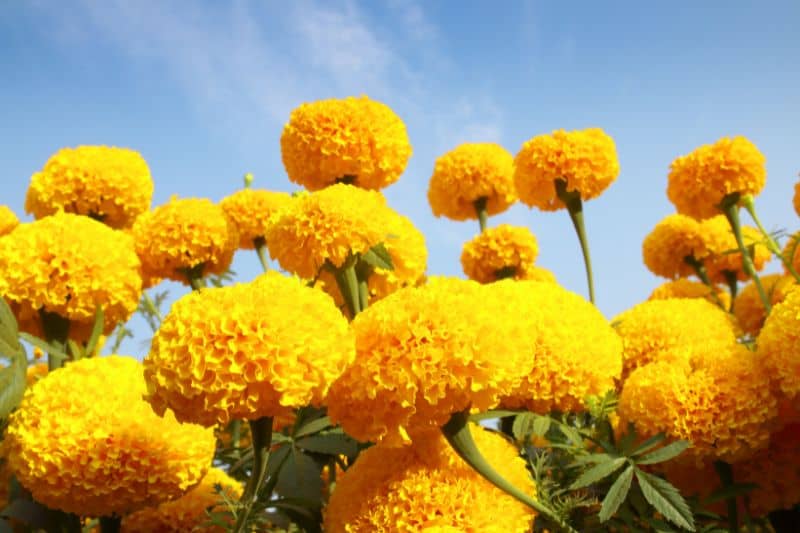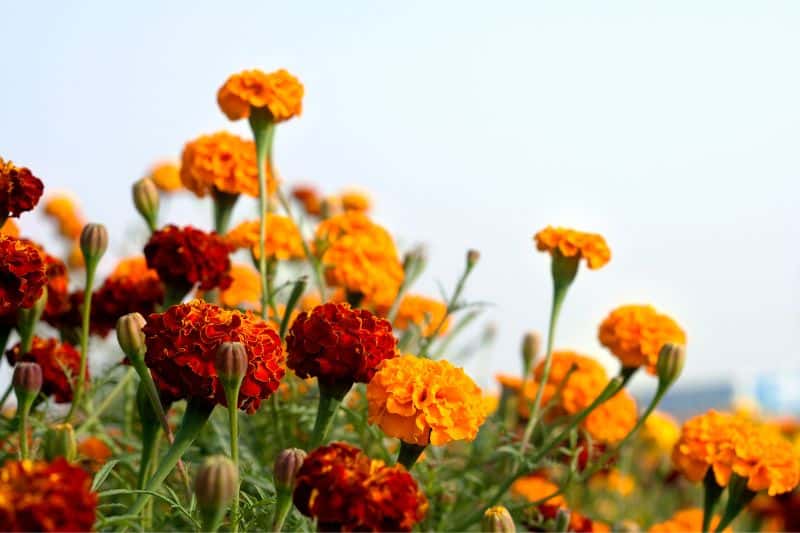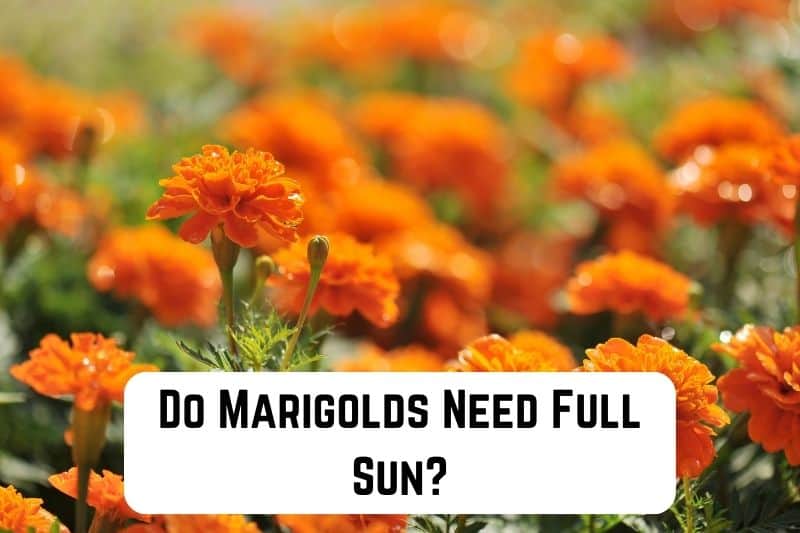Marigolds are valued well beyond their beautiful white, yellow, and orange blossoms. In addition to their showy garden interest, marigolds make excellent companion plants due to their ability to attract pollinators and act as organic pest control. But, do marigolds need full sun?
Climate plays a crucial role in the growth and development. Whether it’s keeping your garden brightly colorful or attracting ladybugs, marigolds need the right conditions to thrive. Understanding their environmental needs allows you to provide proper care as well.
We’ve shared marigold lighting needs to ensure you achieve beautiful bountiful blossoms – with sufficient pollinator-attracting qualities.
Read: Do Coneflowers Need Full Sun?
Do Marigolds Need Full Sun or Shade?
All three main types of marigolds have similar lighting needs. Like most annuals, the growth and survivability of marigolds is influenced by sunlight. Additionally, sunlight impacts their flower growth and abundance.
Marigolds need full sun to grow and bloom to their full potential. When exposed to full sun for longer periods, marigolds produce the prettiest and plentiful flowers. Marigolds also survive partial shade – though they won’t produce as bright or bountiful blossoms.
Marigolds are native to Central and South America where they’ve been growing since the 13th century. But, since their discovery by European explorers, these beautiful flowering plants have been adopted in other regions of the world.
Their spread across other regions has even resulted in the establishment of newer species, i.e. French and African marigolds. Nonetheless, marigolds boast their original drought-tolerant qualities – adapted in their indigenous region today. This explains why marigolds survive best in full sun and even drought-prone regions.
How Much Sunlight Do Marigolds Need?
Marigolds need at least 6 hours of full sunlight exposure daily. Planting marigolds in full sun promotes healthier growth, lush plants, and hefty bloom production. Anything less than 6 hours of sun exposure daily can negatively impact the growth and survivability of marigolds.
Here’s how growing in full sun helps these annuals;
- Fostering fuller and brighter blooms
- Promoting all-day photosynthesis
- Enhancing pollination and pest-controlling qualities
- Disease and pest prevention
- Aiding in Soil Moisture Control
Fostering Fuller and Brighter Blooms
Full sun exposure allows marigolds to produce the brightest and most plentiful blossoms. Marigolds are among the long-lived flowering plants, with flowers blooming from late spring through fall. If you want to enjoy visual interest in your garden through this duration, you need to grow them in adequate sunlight. The more sunlight your plants receive, the better-looking their flowers become.

Promoting Photosynthesis All-day
Sunlight plays an essential role in photosynthesis! For marigolds, fostering all-day photosynthesis is visually displayed in the abundance of the plant. Sufficient sunlight allows marigolds to grow denser and dark green foliage. This, in turn, allows the plants to grow multiple, healthier, and plentiful flowers – with the brightest colors. While different types of marigolds exist, each type uniquely benefits from full sun.
For instance, African and French marigolds blossom in a double-layer pattern. This means that the plant needs to produce twice as much energy to facilitate the growth and development of these flowers. Additionally, the plant needs enough energy to produce beautiful and healthy-looking flowers. This is where exposure to full sunlight jumps in to aid in the deed.
Enhancing Pollination and Pest-Controlling Qualities
In addition to their appealing flower interest, marigolds are favored for their natural pest-controlling qualities. These plants produce an intoxicating floral scent that attracts pollinators while keeping pests away. But, how exactly does this work?
Like other fragrant blossoms, the scent marigolds produce is made from a mixture of volatile organic compounds (VOCs) and essential oils. When emitted into the air, these scents along with the beautiful blossoms they come from attract the pollinators.
The warmer it gets, the more the scent evaporates into the air due to the increased rate of evaporation. Marigolds enjoy more heat and higher scent evaporation rates in full sun exposure. As a result, you get more pollinators to visit the plant.
Among these pollinators are predatory insects that control the population of marigold-loving pests. Pollinators and predatory insects, such as ladybugs, hoverflies, lacewings, and parasitic wasps love to visit marigolds. Similarly, these insects feed on pests, such as aphids, that love to devour marigolds and other garden plants.
Disease and Pest Prevention
Full sun doesn’t save marigolds from pests through pollination alone. Growing in full sun saves marigolds from a host of pests and diseases in many other ways. Some diseases and pest infestations happen due to multiple factors – although proper sun exposure does play a role.
Here’s what growing in full sun protects marigolds from;
- Fungal-caused leaf spots (caused by lack of sun and nutrients)
- Fungal-caused verticillium wilt (caused by lack of sun and nutrients)
- Fungal-caused botrytis and mold (caused by lack of sun, humidity, and moisture build-up)
- Root rot (caused by lack of sun, high soil moisture, and overwatering)
Aiding in Soil Moisture Control
Marigolds need well-drained soil – with no waterlogging – to grow. Waterlogged or wet soil creates an environment for pests and diseases, such as yellow aster and root rot. Wet soil and humidity are the biggest marigold enemies.
While overwatering is an issue, lack of sunlight also affects soil moisture. In addition to maintaining a proper watering schedule, you need to grow marigolds in full sun to control soil moisture.
Can Marigolds Get Too Much Sun?
While marigolds are sun-loving and dependent – they do occasionally get too much sun. Marigolds require at least 6 hours of full sun exposure to flourish so they do handle heat well. But, when paired with other factors, too much sun can affect them.
During summer, especially in warmer climates, heat stress affects even the sun-loving marigolds. Too much heat makes it difficult for marigolds to absorb water from the soil efficiently. However, increasing your watering frequency will only lead to wet soil and limit oxygen access to the root system.
Simply maintain the regular watering frequency and adequate sun exposure during this period. While ensuring sun exposure, you can occasionally move the plants to a partially shaded area. The plants will recover as the temperatures lower towards fall.
After all, you can always tell the difference between heat-stressed marigolds and those suffering from controllable factors, like dry soil. Unlike the visibly browned and crinkled leaves caused by dry soil, heat-stressed marigolds maintain a normal dark green foliage appearance.
In other instances, other factors paired with full sun can be the source of the problem. Infrequent watering or prolonged drought can cause soil to dry out. Growing in full sun, marigold leaves eventually wilt. The good news is most issues can be easily resolved.
In this case, all you do is adjust the watering frequency to get the leaves to spring back to life. After this, simply maintain a consistent and balanced watering frequency to keep the plant healthy. Remember, marigolds don’t like moisture, so don’t think you need to get the soil wet!

Can Marigolds Grow in Shade?
Marigolds cannot grow in total shade. However, they may survive partial shade – albeit resulting in fewer and less bright blossoms. With limited sun exposure, marigold blossoms may not cover the entire blooming period, from spring through fall.
You can grow stronger and healthier marigolds in partial shade by ensuring at least 3 to 6 hours of full sun exposure daily. In fact, placing marigolds in a partially shaded area for a few hours daily can reduce heat stress on the plants.
Here’s what will happen to marigolds without adequate sunlight;
- Fewer and duller blossoms
- Shorter blooming period
- Plants become leggy (thin, long, and flimsy)
- Increased risks of disease and pest infestation
- Overall unhealthy looking plants
- Death (over prolonged periods of no sunlight)
Factors Influencing Sunlight Needs
Sunlight is essential for the survival of marigolds. No matter the location, sunlight is essential for the growth, flower development, and health of the marigold plant. But, location does influence the sunlight needs. For instance, marigolds growing in cloudy regions require more than 6 hours of sun exposure daily for sufficient growth and development.
Similarly, in wet regions, marigolds require more than 6 hours of sun exposure to balance the soil moisture. The type of marigolds also impacts sunlight needs and tolerance. For example, while African marigolds can tolerate high temperatures and intense heat, French marigolds aren’t as tolerant of high heat.
Intense heat can easily damage the delicate flower petals. In addition to understanding your geographical and environmental settings, you have to pick suitable marigold cultivars for the best results.
Read: Do Maple Trees Lose Their Leaves?
How To Grow and Care For Marigold Flowers?
- Marigolds thrive in well-drained, rich, and loamy soil (pH 6.0 to 7.0)
- Plant marigolds in spring for next summer’s bloom
- Marigolds can be grown indoors for about 2 weeks – from seed to sprout
- Marigolds only need full sun exposure after sprouting
- Marigolds prefer warm temperatures and full sun for a minimum of 6 hours daily
- Planting marigolds in pre-fertilized soil sustains their nutrition for long enough
- Maintain a watering schedule but avoid making the soil too moist
- Marigolds are self-seeding and don’t necessarily need deadheading






